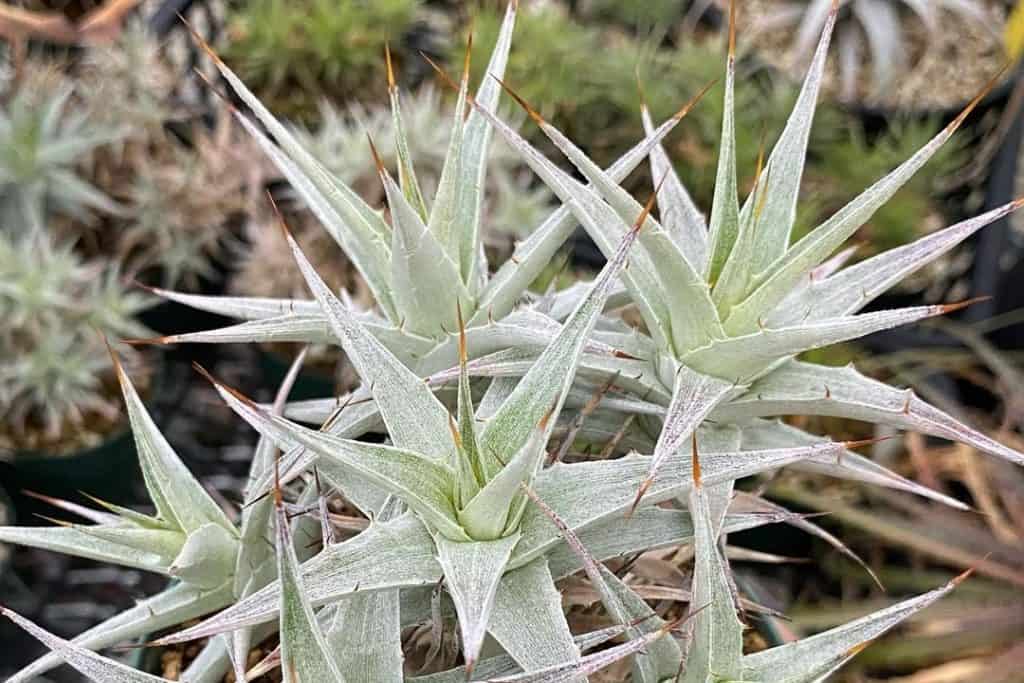Deuterocohnia lorentziana: Characteristics and Care
You know what they say – don’t judge a book by its cover! The Deuterocohnia lorentziana might look fierce and untamed with its spiky leaves, but deep down, it’s a total sweetheart. This quirky little bromeliad is about to become your new plant bestie once you get to know its secrets. Keep reading to uncover the mysteries of this silvery gem!

Contents
About Deuterocohnia lorentziana
This funky little plant hails all the way from Bolivia and it’s ready to bring some serious personality to your plant collection! Deuterocohnia lorentziana forms dense, mounded clusters of rosettes that can reach up to 2 feet tall when grown up. But don’t let the height fool you – those individual rosettes only span around 1 inch wide. Talk about a tiny but mighty plant!
The real showstoppers are the leaves though. Shaped like stiff triangles, they’ve got sharp tips that’ll remind you of a cactus’s prickles. But here’s the plot twist – those leaves are actually covered in a soft, fuzzy layer of white reflective hairs! It gives the whole plant this mind-blowing silvery glow that’s equal parts edgy and elegant.
Just when you thought it couldn’t get any cooler, Deuterocohnia lorentziana busts out its flowering game in late winter to early spring. We’re talking cheerful yellow-green blooms around 1 inch long that pop against all that silvery fuzziness. It’s like the plant’s way of reminding you that even the toughest exterior can have a softer, sunnier side!

Related Post:
1,000 Types of Succulents With Pictures
How to Care for Deuterocohnia lorentziana
Light
These silver stunners absolutely adore sunbathing. Position your Deuterocohnia where it can bask in direct morning sun. As the afternoon rays get more intense, provide some shade. If you lack sunny spots indoors, grow lights can substitute.
Water
Like a kid in a candy store, Deuterocohnia gets overexcited with too much water. Allow the soil to fully dry out before watering again during spring and summer. In winter, limit water to prevent rot. This drought-resistant diva can handle missed waterings like a pro.
Soil
A well-draining, nutrient-rich soil mix is key. Use a standard potting mix and add humus, perlite, peat or bark to improve drainage and airiness. The soil shouldn’t stay soggy which can lead to problems.

Fertilizer
You don’t need to spoil Deuterocohnia with frequent feedings. An occasional diluted, balanced fertilizer at the start of the growing season gives it a nice energy boost. But it grows perfectly content on just the organic matter in the soil too!
Temperature and Humidity
Native to Bolivia, this bromeliad craves warm and toasty conditions like in spring and summer. It can handle average household humidity too. Once temperatures dip below 20°F in winter, bring it inside to prevent cold damage.
Pests and Problems
The biggest issue is overwatering which can cause dreaded root rot. Otherwise, Deuterocohnia is pretty low-maintenance and pest-resistant when healthy. Keep an eye out for any unwanted critters trying to snack on those soft leaves though.
Pruning
Thanks to its naturally tight, slowly spreading rosette shape, pruning isn’t really needed for Deuterocohnia. You can snip off any damaged or dying leaves if they bother you though.
Potting and Repotting
A well-draining pot is all this bromeliad needs to feel at home. And since it grows at a snail’s pace, you’ll only need to give it a new roomier home once every few years as it expands.
Propagating Deuterocohnia lorentziana

The best part about this silvery stunner? Deuterocohnia lorentziana lets you multiply your plant collection easily through propagation! You’ve got a couple of different routes to grow a new generation.
From Seed
- For the patient growers, you can start from seed. It’s a slower process but so rewarding!
- You can either germinate the seeds first by sowing them in a sterile seed-starting mix and providing warm conditions. Once sprouted, transplant the seedlings carefully into individual pots.
- Or skip the extra step and directly sow the seeds into a well-draining potting mix about 1/4 inch deep. Keep the soil lightly moist and warm until they sprout.
- Whichever method, know that seedlings will take several months to over a year to develop into mature rosettes.
From Offsets
- Over a couple years, Deuterocohnia will naturally produce offsets – tiny plantlets developing at the base.
- Once a few inches tall, use a clean sharp knife to gently separate the offsets from the mother plant, trying to keep some roots intact.
- Allow the offsets to callus over for a few days before potting them up in fresh succulent/cacti mix.
- Slowly adjust the new plants to the normal water and light conditions over a few weeks.
- You can also use a rooting hormone powder to encourage faster rooting if desired.
From Stem Cuttings
- Harvesting stem cuttings is trickier but can be done in a pinch if you don’t have offsets.
- Use clean shears to snip off a few inches of the bromeliad’s stem with leaves attached.
- Allow the cuttings to dry and callus over for a few days before trying to root them.
- Once calloused, you can dip the ends in rooting hormone and pot the cuttings in well-draining soil.
- Be patient – it can take several weeks or months for the cuttings to root and grow.
No matter which propagation path you choose, take your time and care for the new plants properly. Soon you’ll have an entire Deuterocohnia lorentziana family to admire!
